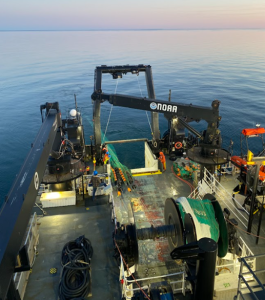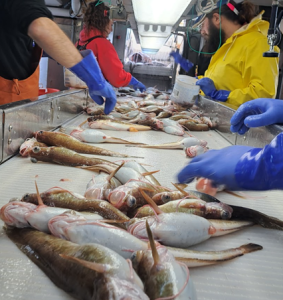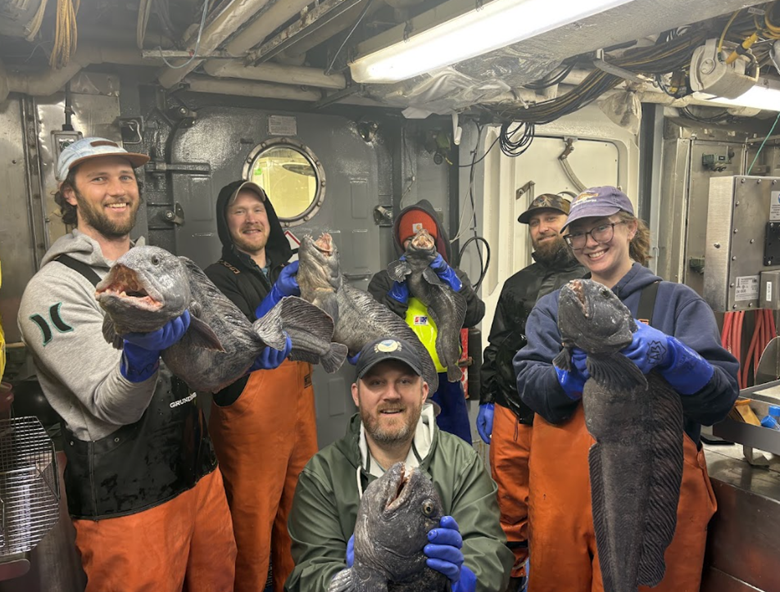By Jenn Casey, IBSS Biological Technician

Hauling back the bottom trawl net aboard the Henry B Bigelow on a calm evening. Credit: NOAA Fisheries/Andrew Jones
The Northeast Fisheries Science Center has conducted Spring and Fall Bottom Trawl Surveys from Cape Hatteras, North Carolina to Nova Scotia, Canada for the past 62 years. The purpose of these ongoing surveys is to gather population abundance, distribution, size, age, sex, maturity, and feeding ecology data for economically and ecologically important fish and invertebrate species. This data is used to inform stock assessments and fisheries management practices and supports a variety of private and public research programs. The Spring Bottom Trawl Survey aboard the R/V Henry B Bigelow just wrapped up in mid-May after conducting sampling at more than 350 stations. The scientific party responsible for the collection of fisheries data is composed of 15 individuals: 1 chief scientist, 2 watch chiefs, and 12 biological technicians. Sailing with a large group ensures that fishing operations occur around the clock – as long as the weather cooperates!

IBSS’ Todd Mihal pushes the catch from the checker pen onto a conveyor. Credit: NOAA Fisheries/Catherine Foley
During each tow, bottom trawl gear is fished on the sea floor for 20 minutes and is hauled back up to the surface to be brought on board. Catch is then dumped into a holding area called the “checker pen” and then pushed onto a conveyor that brings it into the wet lab where technicians are waiting to sort each animal by species. Once all the animals are sorted, the technicians work in three pairs to gather biological data and ensure it is accurately recorded into an electronic acquisition system. When working up a basket of fish, the technicians begin by taking a length measurement on each individual. Depending on the species and the area fished, scientists may also be tasked with determining an individual’s sexual maturity stage, perform a stomach content analysis, and/or collect otoliths (fish ear bones) that can be used to determine the age of the animal. All of this data is later used by scientists to analyze the health of fish populations and marine ecosystems.

IBSS’ Todd Mihal, Jenn Casey, Eric Bovee, and Tom Arthur sort catch by species. Credit: NOAA Fisheries/Catherine Foley
Perhaps one of the more thrilling parts of sailing on the Bottom Trawl Survey is getting to see what comes up in the net. Although predictions can be made on what species will be present based on the season and area fished, every catch is different. There is always anticipation that an impressive organism or less common species might come up in the gear. This season, the Leg III Night Shift crew was excited to find that an early morning tow contained five Atlantic wolffish. These fish are bottom dwellers, living and nesting in rocky, cave-like habitats. Their intimidating, large teeth allow them to feed on hard-shelled prey such as crabs, urchins, and sea scallops. Because of this diet, wolffish loose and replace teeth annually, and it goes without saying that Technicians are extra cautious to avoid their mouths when handling! There is always a great deal of fun and learning to be had out at sea with the Northeast Fisheries Science Center Surveys. Thank you to all the federal and IBSS staff who made this Bottom Trawl Survey season a great one!





